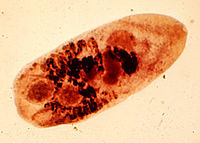
Photo from wikipedia
The food-borne liver trematode Opisthorchis felineus causes severe liver damage, including fibrosis. This study shows a comparison of the characteristics between cholangiofibrosis and periductal fibrosis in infected people and in… Click to show full abstract
The food-borne liver trematode Opisthorchis felineus causes severe liver damage, including fibrosis. This study shows a comparison of the characteristics between cholangiofibrosis and periductal fibrosis in infected people and in the golden hamster as an experimental model. Comparative evaluation was carried out regarding collagen composition, the number of basic-producing cells, and extracellular-matrix degradation. The results revealed that characteristics of chronic opisthorchiasis due to O. felineus infection in humans and in Syrian hamsters are similar and include well-pronounced development of fibrotic complications in the liver parenchyma. Besides, a difference in fibrogenesis development was demonstrated between chronic O. felineus infection and noninfectious cholecystitis. In this study, we for the first time compared fibrogenesis between humans and model animals against the background of chronic O. felineus infection.
Journal Title: Experimental and molecular pathology
Year Published: 2019
Link to full text (if available)
Share on Social Media: Sign Up to like & get
recommendations!